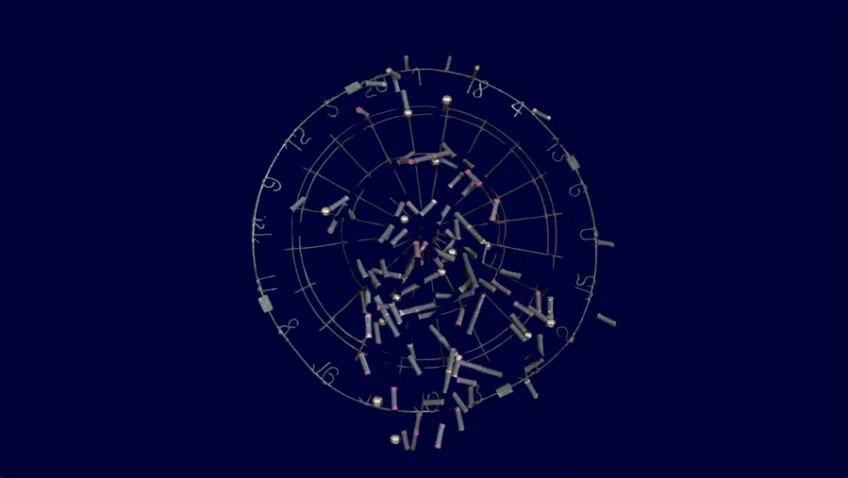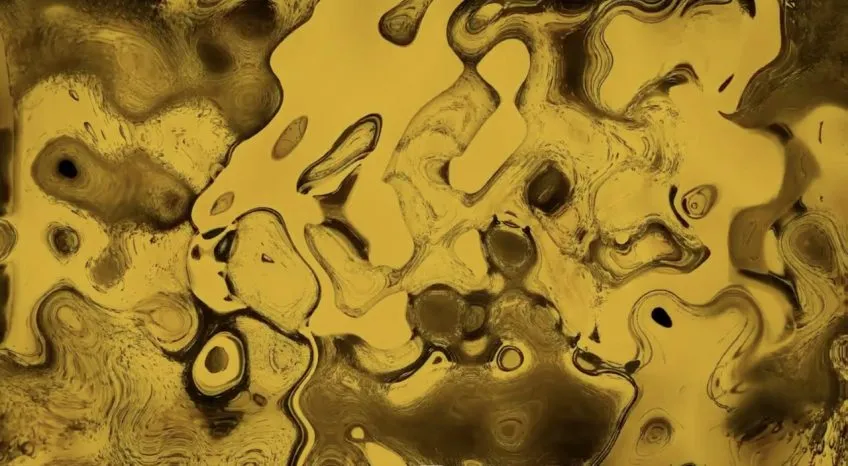An ‘Exquisite Moving Corpse’ made by 60 artists in pandemic isolation exhibits at the Gary R. Libby Focus Gallery
The Exquisite Corpse method pioneered by the French Surrealists serves as the model for ‘Exquisite Moving Corpse,’ an hour-long video collaboration organized during the COVID-19 pandemic by Chip Lord, Jack Massing, and Sean Miller with 57 additional artists.

Learning about ‘Exquisite Moving Corpse’ (2022) feels something like unfolding a piece of paper that reveals a fascinating new fragment of detail between every crease.
Historical parallels and deviations from its interwar ‘Exquisite Corpse’ predecessor, Zoom meetings in lieu of cafe gatherings, the universal human desire to be seen and heard and experienced, sparks of synergistic spirit, shouts from lonely silos of pandemic isolation, elements of precise intention, accidents of chance… Every snippet of the ‘Exquisite Moving Corpse’ story is as surprising as it is painstakingly pieced together.
A 60-artist collaborative video project, ‘Exquisite Moving Corpse’ is both diary and documentary—and also, emphatically: neither of those things. It is unpredictable, abstract, and simultaneously: a time capsule that captures a collective experience with startling specificity.
Each of its 60 one-minute-clip video components is skeleton and viscera and electrical impulse that, when stitched together into one, cohesive hour, makes about as much sense as any living form does if you start thinking too deeply about the bizarre miracle of existence.
Three longtime artistic collaborators—pioneering video artist and co-founder of the Ant Farm avant-garde architectural design group, Chip Lord; conceptual performance artist, Jack Massing of The Art Guys, and sculptor, interventionist artist, and University of Florida College of the Arts associate professor, Sean Owen Miller—schemed up ‘Exquisite Moving Corpse’ during a series of Zoom calls at the beginning of the COVID-19 pandemic. Then, they reached out to 57 artists, spaced geographically from Texas to Finland, to create it.

The one-hour video took approximately two years to complete. ‘Exquisite Moving Corpse’ began its international journey this summer, starting in the southwest U.S. and touring to Italy and Ireland before heading to NYC.
Sometimes it’s a video installation, sometimes it’s a sit-down theatrical experience, but what it’s most certainly not is a movie. It’s a video organism. Where it goes, how it moves, what it does, and in what form this body of work will live beyond its exhibition tour? To be determined.
‘Exquisite Moving Corpse’ is in motion, making its latest stop at UF’s Gary. R. Libby Focus Gallery, August 26 – September 30, 2022.
Art historical debrief: from Exquisite Corpse to ‘Exquisite Moving Corpse’
The Exquisite Corpse method originated among French Surrealists—André Breton, Jacques Prévert, Yves Tanguy, and friends—sometime in the late 1910s to mid 1920s, and remained active in Surrealist circles through the 1930s. Artists associated with the Dada movement, like Marcel Duchamp and Man Ray, also participated.
In the Exquisite Corpse method, images or words are collectively assembled in a sequence, with each contributor creating their own section and folding the paper so that the next collaborator in the sequence can only see the last lines drawn or written by the previous artist.
In ‘Exquisite Moving Corpse’: a sequence of 60 artists scattered across the globe makes one-minute videos, having only viewed the last frame of the clip that precedes them.
The first minute of ‘Exquisite Moving Corpse’ stars a replica of Marcel Duchamp’s readymade ‘Bicycle Wheel,’ handcrafted and filmed by Lord at his home in San Francisco. Massing picks up from Lord’s final frame (a fixed shot of the bicycle wheel amongst the nasturtium in Lord’s garden) with a video portrait of a solitary truck tire in a field in Texas—a visual subject which Miller, located in Gainesville, borrows for the third minute. Miller investigates the rubber tire under a microscope before discarding it in a junkyard pile. By the fourth minute, Miller’s tire pile morphs into Chiaozza’s bowl of Cheerios—and so on.
Chip Lord, Jack Massing, and Sean Miller sat down for a series of conversations with UF COTA’s In the Loop to discuss ‘Exquisite Moving Corpse.’ In the spirit of the original method, we’ve stitched together some of their most fascinating insights in the following Q&A.
‘Exquisite Moving Corpse’ Q&A with Chip Lord, Jack Massing, and Sean Miller
Loop:‘Exquisite Moving Corpse’ [EMC] originated very early on in the COVID-19 pandemic lockdown. Can you share more about how the project came to be?
Sean Miller: In conversations happening over Zoom between Chip and Jack and me, we were saying things like, ‘well, what are you doing?’ because we were all just trying to figure it out: you can’t go anywhere, your studio practices are disrupted, a lot of shows got canceled or put off for a year. It felt like being in creative limbo. Like many artists, we were spending a lot of time talking about how COVID had changed our studio practice—and the conversation turned to the idea of the Exquisite Corpse as a model.
I think that with ‘EMC’—at least based on the responses I got when I invited people—there were some that, probably if it had been ‘normal times,’ might have said no. But because they were looking for something different—and they were feeling different—they said yes.
Jack Massing: The pandemic was not the driving force doing this—but it was the gateway that opened to allow it to happen, because we were, in essence, forced into thinking differently—because the world was different.
A lot of film is considered to be entertainment—even documentary films; even the ones on difficult subjects. But the ‘Exquisite Moving Corpse’ is not that. It’s not a narrative. It’s not a story arc. There’s no protagonist or antagonist. But the itself is a time capsule of 60 different people responding to and relating to the pandemic in 60 different ways. Everybody is going to respond to it differently.

Loop: In what ways would you say ‘EMC’ is similar to the original Exquisite Corpse? How do they differ?
Chip Lord: I would say it’s similar in the very specific structure of how it is created—and that’s it. Exquisite Corpse was a hundred years ago. The time we live in now is so different. The original Surrealists sitting at a French cafe table and passing a piece of paper around becomes this global ‘passing around the idea’ in video—which is such a popular and available artistic medium today. We live in a time where everybody has a video camera in their pocket all the time. So [EMC is] connected to the time we’re living in—the technological changes and what it means to be an artist and a video maker.
JM:There’s a specific sharing of ‘idea’ in it—in that it’s not a virtuosity of technique; it’s a virtuosity of spirit. The spirit of experimentation and collaboration is inherent in the Exquisite Corpse as well as the ‘Exquisite Moving Corpse.’ And the ‘table that we’re sitting around’ is the Internet.
SM: Something I find curious is—and we didn’t plan this—is that when you look back at the dates when Exquisite Corpse started, it was right around the same time as the global pandemic [of 1918]. That, to me, was really surprising: that we were in lockdown and came up with our strategy, then looked back and realized [the Surrealists] came up with that strategy right around the same time, or just a few years after, the flu.
Loop: Please share a little about the process of working with 60 artists to make ‘EMC.’
JM: It was like trying to manage a wheelbarrow full of frogs! Even through the simplicity of email and the Internet, it was very difficult to get everything corralled … Sean nominated 19 artists, Chip nominated 19, and I nominated 19—thereby having 57 artists, plus each of our own three minutes.
SM: Since we didn’t have a piece of paper, we used video. We told people they could record it using their phone, because not everybody involved is really steeped in video art. We were more interested in creating a collective group of people who we knew would fit into the project and make interesting responses.
CL: [The collaborator list] was something that evolved while we were doing the project. I was constantly reshaping mine. I was very conscious that I wanted to bring in a younger generation of people, so there are several former students of mine … It’s a mixture of people of my generation who are well known in the art world, and others whose names I had never seen before they appeared on the list, nominated by Sean or Jack. There’s a great deal of diversity.
Jack took on the technical direction, in a sense of: somebody had to create that final frame that was sent to the next person—a huge job. It couldn’t have been just tossed back and forth; it wouldn’t have worked.
SM: We assembled all the emails and curated all the artists, and then Jack would choose which artist to go next [in the sequence]. For a lot of the process, Chip and I didn’t know what was happening because Jack was just collecting each bit of footage and slowly putting it together with the rest.
JM: I’ve been using the word ‘liaison’ for the transitions as a nod to the French Surrealists. ‘Liaison’ is a really wonderful word, where one idea is propagated by the previous idea. Linguistically, it’s vowels flowing together. I think the visual idea of ‘EMC’ has visual qualities [of each clip] then moving together—and the liaison is the single frame.

Loop: Each of you have worked on collaborative projects that act as monuments to a specific place or moment—like Ant Farm’s ‘Cadillac Ranch’ and ‘time capsules,’ or Sean Miller’s ‘Crude Life’ and ‘Drifting Cabinets.’ Of course, ‘EMC’ is a much different medium than, say, a rusted old Cadillac or a piece of luggage. It’s not made to inhabit a physical space for the long-term—but would you call it a time capsule of its own, nonetheless?
JM: Without a doubt, yes. Chip is very cognizant of history in that way. Quite frankly, any film or video is a time capsule. It doesn’t matter what it is—it records a moment that will never be again. That’s basically the nature of film. It is a time capsule, inherently.
Marshall McLuhan [the Canadian communication theorist] was a very big influence on Chip and Ant Farm, and also on The Art Guys, [in regard to] ‘the medium as the message’ and the other ideas McLuhan wrote about. And the Internet is probably the biggest prediction that McLuhan made back in the 1950s—although he didn’t describe it exactly as it is. But he knew it was coming, somehow. Using a McLuhan-esque device like the Internet to propagate an artwork like ‘EMC’ is, to me, very fitting.
Loop: What happens when a work like this reaches the end of its exhibition run? Does it go into a museum collection? Upload it to the Internet and see what happens? Can you do either of those things—or do issues like artist ownership and copyright crop up?
JM: Chip and I can relate from being collaborators on things that end up getting legs: you have to babysit them all the time … I mean, ‘Cadillac Ranch’ has to take so much time out of Chip’s life over the last 40 years. So, after the end of this year: I think we’re just going to let ‘EMC’ do whatever it does.
CL: We haven’t fully arrived at the final solution to that question—‘is it something that would go into a museum collection?’ for example. But it raises an interesting point about the project—which is that we didn’t have contracts.
When we invited people, we just said: ‘make a one minute film. We’re going to compile it based on the last frame.’ And nobody ever said, ‘my dealer doesn’t want me to do this,’ or ‘I want to maintain control over my work, so I’m not going to participate for that reason.’ Not one of the 57 people that we invited came back with that. Everybody just jumped into it … It’s been really refreshing to be unencumbered by those questions and potential conflicts.

Loop: On that note: any closing thoughts on ‘EMC’—on the scope of it; on the value of such a unique collaborative undertaking?
SM: Just starting with the name—the idea of a corpse or a body—and also noting that the root word of curation, or curating, is ‘curia,’ which means ’to care for.’ So, there’s this idea of setting something in motion and then caring for it from beginning to end.
I really like the idea of it as a collective art making strategy: the idea that you’re on your own in this one little area, but you know that you have to do it well. You’re a part of a group that’s trying to make something happen. There are elements of chance to it, but there’s also this idea that you’re on a team; that you’re working on something together.
The ‘EMC’ showings in Venice and Genoa, Italy were shows with the composer and Fluxus artist, Philip Corner— and the Fluxus art movement has a real collaborative spirit to it. Those shows definitely focused on screening the video—but also on showing the ways you can collectively perform through written scores, through performance art, with Fluxus Kits.
I think that’s a really important association to make because the Surrealists and Fluxus have similarities in their thinking and methodology—and, really, there’s this similar strain moving through all of this.
See ‘Exquisite Moving Corpse’ at the Gary R. Libby Focus Gallery August 26 through September 30, 2022.

Additional UF COTA artists whose work appears in ‘Exquisite Moving Corpse’ are:
- Sergio Vega, PhD, Professor, School of Art + Art History
- Craig Smith, PhD, associate professor, School of Art + Art History
- Adebukola Buki Bodunrin, BFA, 2005
- Adam Frezza, MFA, 2007
- Leah Floyd, MFA, 2011
- Christina Molina, MFA, 2012
- Emmanuel Opoku, MFA, 2021
- Exhibition text for ‘Exquisite Moving Corpse’ written by UF School of Art + Art History assistant professor, Rachel Silveri, PhD.
 Featured Image Caption: ‘Exquisite Moving Corpse’ opened at the UF Gary R. Libby Focus Gallery on August 26. The exhibition runs through September 30, 2022.
Featured Image Caption: ‘Exquisite Moving Corpse’ opened at the UF Gary R. Libby Focus Gallery on August 26. The exhibition runs through September 30, 2022. Featured Image Detail: Still from ‘Exquisite Moving Corpse’ by Sergio Vega, Minute #7, 2022.
Featured Image Detail: Still from ‘Exquisite Moving Corpse’ by Sergio Vega, Minute #7, 2022.